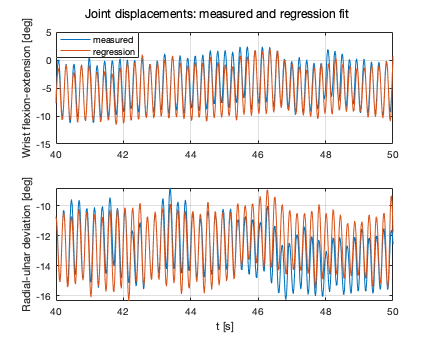Category: Tremor
Objective: The purpose of this work is to validate a mathematical model of postural tremor to predict tremor at the hand from measurements of tremorogenic activity in the muscles of the upper limb.
Background: Tremor is a common movement impairment without existing treatment options that are both low-risk and highly effective. There is potential for peripheral suppression methods, but optimizing these methods requires a better understanding of how tremor mechanically propagates through the upper limb. A previously developed mathematical model relating muscle activity to tremor revealed general principles of tremor propagation in the upper limb [1], but this model has not yet been validated and cannot yet be tailored to an individual person. This study aims to both validate the postural tremor model and develop a method for tailoring the model to a given subject.
Method: For preliminary validation, we focused on the wrist using a sub-model that included four muscles (prime wrist movers) and two degrees of freedom (wrist flexion-extension and radial-ulnar deviation). Surface EMG in these muscles and motion capture in these degrees of freedom were collected from five subjects with Essential Tremor while they extended their hand against gravity for three trials of 120s.
System identification was performed to estimate the subject-specific model parameters. In essence, we reformulated the model into a form suitable for linear regression and regressed the data against the model. The resulting regression coefficients are nonlinear functions of the physically meaningful model parameters. Thus, after implementing regression, nonlinear optimization tools were utilized to extract the model parameters from the regression coefficients.
Results: The regression fit the experimental data well [figure1], with Variance Accounted For (VAF) ranging from 86 to 98%. We are in the process of using nonlinear optimization algorithms to obtain the physically meaningful parameters of the model.
Conclusion: If the estimated model parameters are comparable to literature values and have acceptable variance, the model is validated, and the described methods can be repeated to find subject-specific model parameters for other subjects. The next goal is to extend these methods to the full upper-limb model.
References: [1] T.H. Corie et al, Journal of Biomechanical Engineering, 2019.
To cite this abstract in AMA style:
S. Ward, S. Charles, D. Farina, M. Allen. Validation of postural tremor model using regression and optimization [abstract]. Mov Disord. 2021; 36 (suppl 1). https://www.mdsabstracts.org/abstract/validation-of-postural-tremor-model-using-regression-and-optimization/. Accessed January 4, 2026.« Back to MDS Virtual Congress 2021
MDS Abstracts - https://www.mdsabstracts.org/abstract/validation-of-postural-tremor-model-using-regression-and-optimization/

